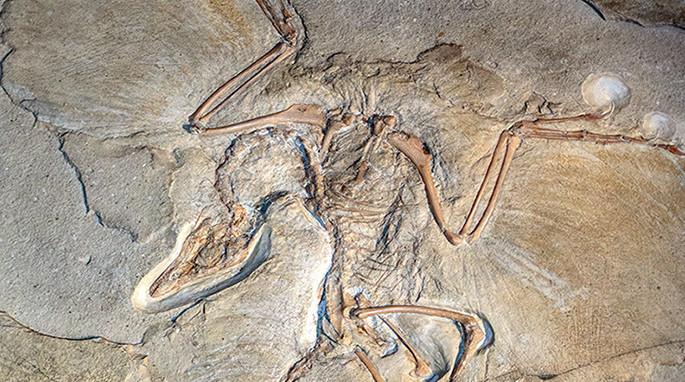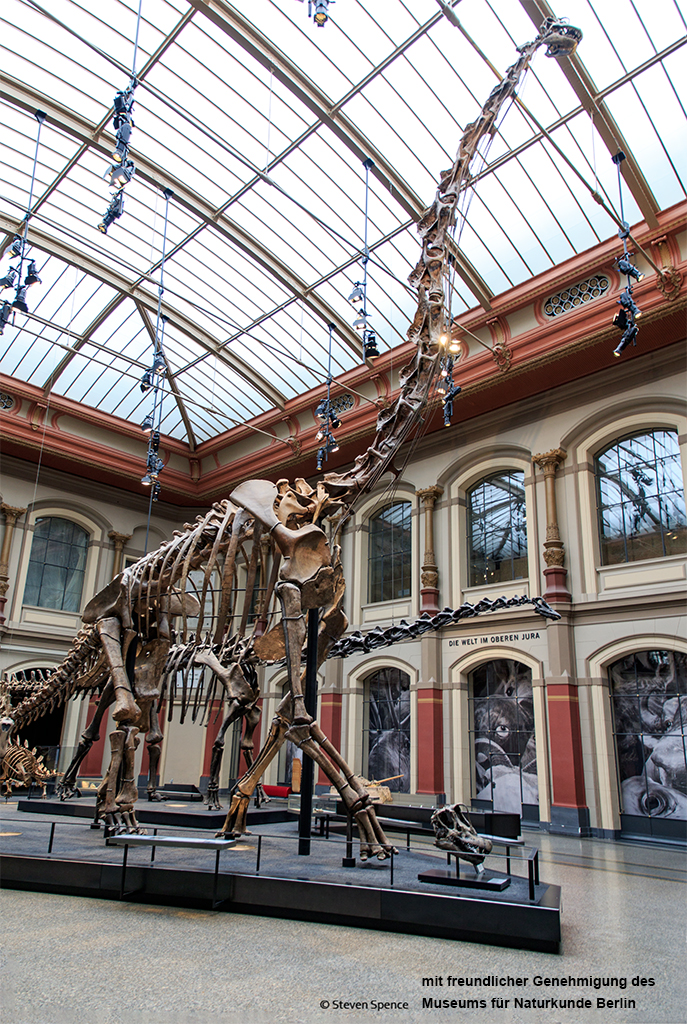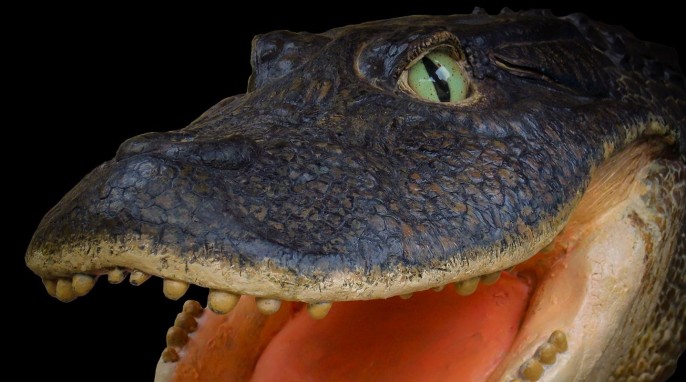Jurassic Celebrity: Early Bird Gets the Spotlight
A Lasting Impression
For its sheer beauty, the Berlin specimen of Archaeopteryx has been described as a “paleontological Mona Lisa” by Dr. Luis M. Chiappe of the Natural History Museum in Los Angeles. Without a doubt it is one of the most attractive fossils that I have ever seen. It is striking because it clearly has avian features, yet it is so different from modern birds.
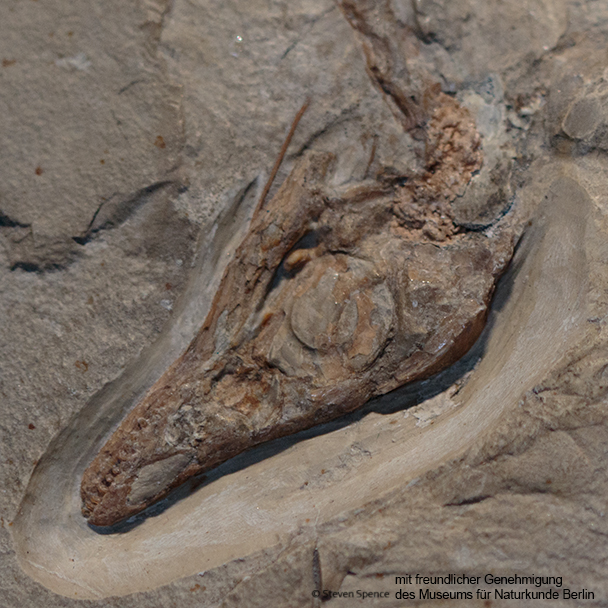

Clawed Wings and Teeth
A previous article on the reference specimen of Archaeopteryx (London Natural History Museum) mentioned both the claws and the teeth. The London specimen’s counterslab contains a piece of the jaw including a few teeth. The Berlin specimen still has the head attached and it is very easy to see the teeth, which are a feature no longer present in modern birds.
Equally impressive are the digits of the hands and especially the claws on the wings. There are a few living birds that have claws on their wings, but these are not the same anatomically or functionally. The most common comparison made is to the hoatzin, which has two claws while it is a fledgling.
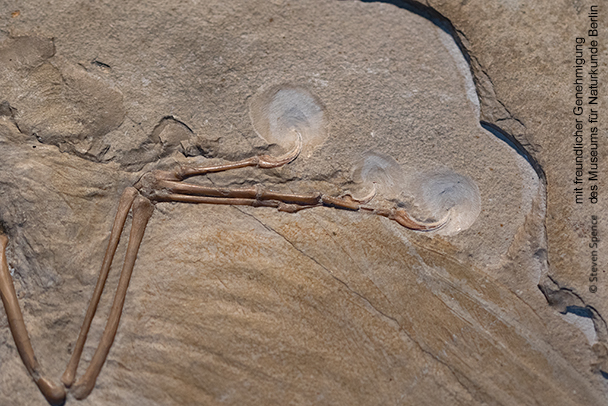

The claws on the hoatzin are used as part of a survival mechanism. Hoatzin nest sites are built in trees above water in the Amazon and Orinoco River basins. If the fledgling needs to flee the nest to escape a predator or if it should fall out, it will land safely in water and be able to climb back up the tree. The claws on the wings are helpful in latching onto twigs and branches, so it can get out of the water. As an adult the claws are lost.
The Archaeopteryx had claws on its wings as a fledgling and an adult. The hands and fingers that form the wing structures are very similar to those of maniraptor dinosaurs—a group of bipedal theropods that are closer to birds than other dinosaurs. In fact, the anatomy of Archaeopteryx is so similar to maniraptors that several Archaeopteryx fossils were initially classified as a dinosaur named Compsognathus. Only after a closer examination of the feather impressions were the mistakes rectified.
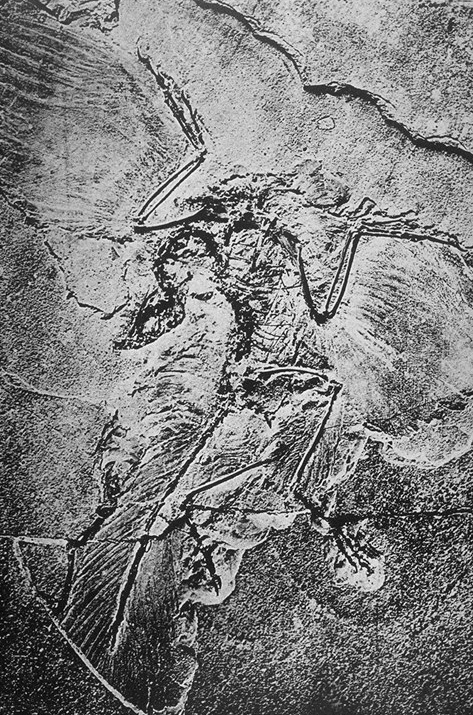

Jurassic Feathers: Blessing or Curse?
The feathers that make the Berlin and other specimens so valuable as fossil records are also are a curse. They prevent the extraction of the complete fossil from the matrix it is embedded in because there is no way to physically remove the fossilized bones without destroying the evidence of the feathers. Compare the 1880 photograph of the Berlin specimen with how it looks currently: It is obvious that feathers on the legs were chipped away during preparation of the specimen. Fortunately, modern technology and multiple specimens have given us a very good idea of the dinosaur’s anatomy so that reconstructions are possible.
London, Berlin: How Many More?
We’ve been very lucky with Archaeopteryx. Sometimes scientists only have one specimen of a species to work with because not everything gets fossilized and we don’t find everything that has been fossilized. There are twelve specimens in total. One is missing, thought to be in a private collection, and two others are recent finds still to be formally described. All the specimens, except the Thermopolis, Wyoming example, are in Europe.
All 12 Known Archaeopteryx Specimens
- A single feather was discovered in 1861 and described scientifically by Christian E. H. von Meyer. Until recently, this feather was the reference for the species because it was the first fossil from the species described scientifically. Specimens are displayed in the Berlin Museum für Naturkunde and of Munich University in the Bavarian State Paleontology and Geology Collection. This isolated feather is attributed to Archaeopteryx.
- The London Specimen (Natural History Museum), unearthed in 1861, is now the holotype or reference for the species because it was the first complete skeleton of Archaeopteryx scientifically described.
- The Berlin Specimen (Museum für Naturkunde) was found in 1874 near Eichstätt, Germany. It was scientifically described in 1884 by William Danes. This is the most complete specimen and it was the first one found with the head attached. In my opinion it is the most attractive of all the Archaeopteryx fossils.
- The Maxberg Specimen is missing. It was discovered in 1956 and displayed in the Maxberg Museum in Solnhofen, Germany until 1982 when its owner, Edward Optisch, took it to keep in his home in Pappenheim, Germany. The fossil has been missing since Optisch’s death in 1991 and now thought to be in a private collection. I hope that it will reappear and be acquired by a museum for public display. This could be a job for Indiana Jones.

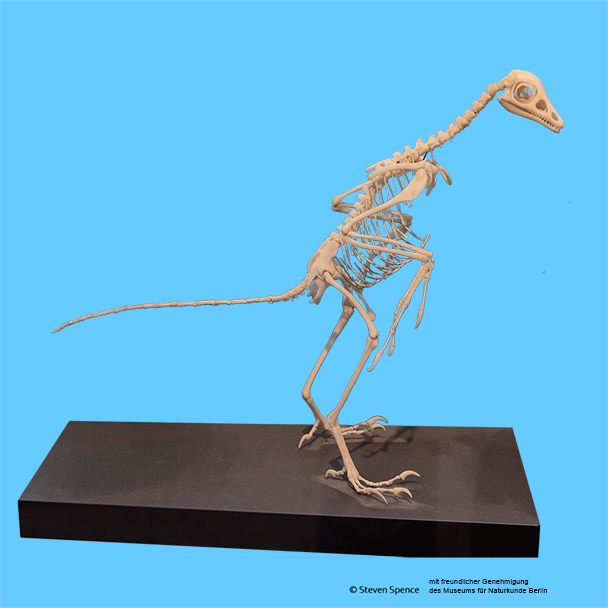
Model of Archaeopteryx (Museum für Naturkunde Berlin) - The Haarlem Specimen (Teyler Museum Amsterdam, Netherlands) consists of part of a wing, including a claw with a horny sheath. This was the first Archaeopteryx fossil found (1855), but it was initially classified as a pterodactyl. John Ostrom, who was researching pterodactyls in 1970, examined the specimen, saw feather impressions, and immediately realized it was part of an Archaeopteryx. Dinosaurs were a sleepy field of study until the mid-seventies, when new discoveries and ideas stimulated a new and ongoing interest. John Ostrom was one of the first scientists to propose that dinosaurs were both feathered and probably warm-blooded. His work on Deinonychus (1964) and Archaeopteryx (1970-72) were major factors in the on-going “Dinosaur Renaissance”. The many recent finds of feathered dinosaurs in China confirm his pioneering work.
- The Eichstätt Specimen (Jura Museum, Eichstätt, Germany) is the smallest complete specimen. It was found in 1951 and described by Peter Wellnhofer in 1974. This has the second best skull of all the fossils.
- The Munich Specimen (Paleontological Museum, Munich, Germany) was found in 1992 near Solnhofen, Germany. Peter Wellnhofer scientifically described it in 1993.
- The Daiting Specimen was found in 1996. The fossil was purchased by paleontologist Raimund Albertsdörfer in 2009. It was found in limestone beds somewhat younger than the Solnhofen deposits and may represent a different (sub)species.
- The Bürgermeister-Müller Specimen is popularly known as the “Chicken Wing”, because it is only a partial wing. This specimen was found in 2000 and is owned privately, but is on loan to the Bürgermeister-Müller Museum in Solnhofen, Germany.
- Thermopolis Specimen (Dinosaur Center, Thermopolis, Wyoming) belonged to a Swiss collector, but was donated in 2005. It was also scientifically described that year by Mayr, Pohl, and Peters. It is considered the most complete specimen found to date. The head and feet are the best preserved of all examples.
- Unnamed (Ludwig-Maximilians-Universität, Munich, Germany). Discovered in 2011, the specimen is privately owned. Paleontologists of the Ludwig-Maximilians-Universität (Munich) are examining it. This specimen is said to show previously unknown features of the plumage.
- Unnamed (“Altmannstein”). Discovered by a private collector in 2014, the find has not been described yet.
Personal Jurassic Quest
While some people are determined to climb all fourteen 8,000-meter mountains, my personal ambition is to view all 12 Archaeopteryx examples! I may need to engage Indiana Jones to find the missing example, but it’s my hope that a collector will place it on the market and a museum will be able to purchase it for scientists to study and the public to view.
Resources
GotScience.Org translates complex research findings into accessible insights on science, nature, and society. Subscribe to our science newsletter!

